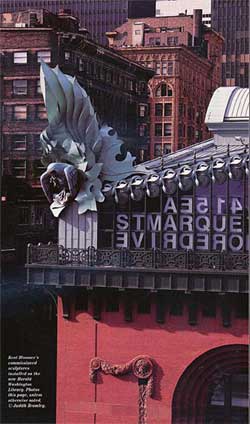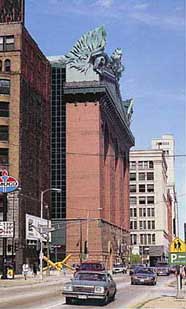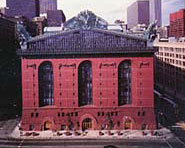When sculptor Kent Bloomer was commissioned to design roof works for a new library in Chicago, his flamboyant solution activated the building.
A few years ago, while visiting my native Chicago, I came upon a building so weird and otherworldly that the sight of it nearly caused me to drive off the road. Dominating a full city block, it was a majestic, fortresslike edifice with a roof that erupted into gigantic, leafy gargoyles. Its exaggerated pomp made it seem at once serious and playful, like something Mussolini might have built if he'd had a sense of humor. My first thought was that I'd accidentally driven onto the set of Blade Runner II, but the building's brick-and-granite facade indicated nothing but permanence. Later I learned this was the new Harold Washington Library, dedicated to the memory of Chicago's first black mayor, and the largest public library in the  United States. The fantastic ornamentation that dominates the building, which was completed in 1994, is the work of sculptor Kent Bloomer and was commissioned by Chicago architect Thomas Beeby, who encouraged Bloomer to bring his individuality to bear on the project. "Few architects today," Bloomer says, "would have the nerve to give such latitude to another creative mind." Beeby's design for the library, with the ornamentation only sketchily indicated, won out over four others in a fiercely contested, highly publicized architectural competition. While the other contenders were somewhat modernist in their approach, Beeby's plan was more historically based, and appealed to the jury's desire for a library that conveyed the look of a substantial municipal building. However, both the plan's detractors and its proponents, such as Chicago architect Stanley Tigerman, expressed concern that the building's look was too traditional and feared it could set the city's architecture back, as happened in 1922 when the extravagantly NeoGothic Tribune Tower by Hood and Howell was chosen in competition over plans by, among others, Eero Saarinen and Walter Gropius.
United States. The fantastic ornamentation that dominates the building, which was completed in 1994, is the work of sculptor Kent Bloomer and was commissioned by Chicago architect Thomas Beeby, who encouraged Bloomer to bring his individuality to bear on the project. "Few architects today," Bloomer says, "would have the nerve to give such latitude to another creative mind." Beeby's design for the library, with the ornamentation only sketchily indicated, won out over four others in a fiercely contested, highly publicized architectural competition. While the other contenders were somewhat modernist in their approach, Beeby's plan was more historically based, and appealed to the jury's desire for a library that conveyed the look of a substantial municipal building. However, both the plan's detractors and its proponents, such as Chicago architect Stanley Tigerman, expressed concern that the building's look was too traditional and feared it could set the city's architecture back, as happened in 1922 when the extravagantly NeoGothic Tribune Tower by Hood and Howell was chosen in competition over plans by, among others, Eero Saarinen and Walter Gropius.
Not to worry. More outrageous than conservative, the finished building is by all accounts a success with the public, even if its merit is still being debated in the design world. This is architecture more aggressive than nostalgic, more idiosyncratic than derivative. What makes it most surprising is that it was carried off on such a grand scale in the public arena, helped along by the nature of competitions, which make it more difficult for the client to modify the plan. "If it hadn't been a competition, Beeby says, "we never would have gotten away with it."
 Beeby's design is loosely based on the concept of a Greek temple: it has a solid base and arcade topped by a glass pediment on which Bloomer's enormous aluminum sculptures are perched. There is a cornice with a railing and, above it, punctuated by spearlike mullions, an eave of running scrollwork in the form of leaves and buds. This eave, which defines the top of the pediment, crescendos at the corners and over the central doorway into huge, flamelike leaves and feathers that twist and swirl around figures of sculpted owls. Centered on the pediments on the narrow sides of the building are equally elaborate seed pods--winged, as if they are about to take flight. While the owls, one of which is reading a book, are common symbols of wisdom and learning, the seed pods, according to Bloomer, are in homage to Louis Sullivan, who saw the seed shape as connoting growth, intelligence, vitality and an aspiring nature.
Beeby's design is loosely based on the concept of a Greek temple: it has a solid base and arcade topped by a glass pediment on which Bloomer's enormous aluminum sculptures are perched. There is a cornice with a railing and, above it, punctuated by spearlike mullions, an eave of running scrollwork in the form of leaves and buds. This eave, which defines the top of the pediment, crescendos at the corners and over the central doorway into huge, flamelike leaves and feathers that twist and swirl around figures of sculpted owls. Centered on the pediments on the narrow sides of the building are equally elaborate seed pods--winged, as if they are about to take flight. While the owls, one of which is reading a book, are common symbols of wisdom and learning, the seed pods, according to Bloomer, are in homage to Louis Sullivan, who saw the seed shape as connoting growth, intelligence, vitality and an aspiring nature.
The central sculpture is 34 feet high and 70 feet long, the corner pieces are 40 feet high and wrap a little more than 20 feet around either side, and all jut out 6 feet past the building's wall so they can be seen from the street directly below. That sculptures of this magnitude could be placed over glass and made to withstand winds of up to 150 mph (30 mph stronger than Hurricane Hugo) is a feat of modern engineering.
With Beeby's sketch as a starting point, Bloomer formulated his ideas by making models out of cardboard, metal, Styrofoam and wood. Although its pale green color suggests weathered copper, the foliage is actually fabricated from sheet aluminum which is cut, rolled into curves by huge industrial rollers or manually twisted with levers, welded into position and painted. Bloomer and Beeby called in Raymond Kaskey (a former student of Bloomer's) to design the owls, which were then cast in aluminum. Bloomer and Beeby provided Kaskey with specifications, but felt strongly that the actual rendering should be of Kaskey's own invention. A large part of Bloomer's philosophy is to acknowledge the expressive contribution that artisans (as well as his own assistant, William Jelley) can bring to a project if given the opportunity. He also doesn't reject the input of the client. "There are good clients," he insists, "people whose ideas, like those of a good editor, can inspire and clarify your objectives."
 Bloomer saw the project as a collaboration that brought out the best in both sculptor and architect. "I couldn't have done what I did," he says, "without the building being the way it is. To pack that much energy into the ornament, for it to be that big, required a very powerful launching platform. Tom's building has a massive granite base which forms a strong pedestal, and a shaft that lifts the eye upward." Beeby concurs, saying that his building was "activated by the roof ornament," which, because of the time it took to fabricate, was added two years after the building was completed. Beeby chose Bloomer, he says, "because he was the only one who could do it. And it was the perfect job for Kent, as if everything in his past led up to it."
Bloomer saw the project as a collaboration that brought out the best in both sculptor and architect. "I couldn't have done what I did," he says, "without the building being the way it is. To pack that much energy into the ornament, for it to be that big, required a very powerful launching platform. Tom's building has a massive granite base which forms a strong pedestal, and a shaft that lifts the eye upward." Beeby concurs, saying that his building was "activated by the roof ornament," which, because of the time it took to fabricate, was added two years after the building was completed. Beeby chose Bloomer, he says, "because he was the only one who could do it. And it was the perfect job for Kent, as if everything in his past led up to it."
Bloomer, 62, majored in physics and architecture at M.I.T. Transferring after four years to study sculpture at Yale, he has hardly left that university since. He received his M.F.A. in sculpture there and, at 24, exhibited in a group show of contemporary sculpture at the Museum of Modern Art. Bloomer's first works were freestanding sculptures composed of undulating ribbons of brass twisted into organic forms. This early interest in voids and continuous surfaces is still evident in his work, and the experience of fabricating these sculptures prepared him, in part, for the challenges posed by the vastly larger Washington Library pieces. "I already knew," he says, "that industrial metal plate could do that."
Bloomer sees himself as a classically trained sculptor. His teacher and mentor at Yale, Erwin Hauer, was steeped in German Expressionism and taught him about sculpture "in the round" and what Bloomer calls the "hard discipline of figurative sculpture." Bloomer worked in stone as well as metal and for inspiration looked to Brancusi and the Constructivists, especially Naum Gabo and his brother, Antoine Pevsner. In hindsight, Bloomer can also trace the effect that Yale's architecture-with its heavy-handed yet often whimsical ornamentation--has had on his work.
But early on Bloomer was beginning to believe "that sculpture should be integrated, part of the language of architecture." In 1964 he won a competition to create a work of art for the Rodef Shalom synagogue in Pittsburgh, for which he made a huge concrete bas-relief of undulating surfaces. The resulting play of light and shadow reflected Bloomer's admiration for Brancusi. "It was a sculptural piece," he remembers, "but I took the architecture into account and rebuilt the wall. The architect hated it." Bloomer went back to freestanding pieces, but now they were an architectural hybrid, incorporating low walls and corners.
In the '70s Bloomer began to study the role of the body in architecture. Body, Memory, and Architecture, which he co-authored with Charles Moore and published in 1977, became something of a classic and is still in print. Since that year he has taught a class in architectural ornament in the Yale architecture department (the only course of its kind in the country) and has become a singular expert in the field.
Bloomer has kept his field of study alive, he says, through sheer stubbornness and a passion for his subject, as well as the support of Beeby and Cesar Pelli, his colleagues at Yale. Despite the flourishes of postmodernism, ornament in architecture has been largely ignored in this century. The International Style, with its emphasis on the utilitarian, may in part be held responsible for the current chasm between architecture, on the one hand, and painting and sculpture, on the other. Lately, however, the argument against ornament has come down to economics, although Beeby insists unornamented buildings are not necessarily cheaper.
Bloomer describes ornament as a type of visual communication that transcends spoken language, a poetic form of storytelling in metaphoric images that can convey the history of a building's site and the expectations for its use. To remove it is to remove a natural level of expression. "Orthodox modern architecture," he says, "has attempted to reduce architecture to its utility. However, in the body of history, architecture has had other purposes. Ornament falls into the space between utility and those esthetic, symbolic and linguistic elements which represent total fulfillment of the architectural idea."
For Bloomer, ornament begins with the body, and he sees its origins in dance. "If you sit in a balcony and watch a ballet," he says, "all you see are spirals. I spent years wondering why ornament was repetitive until I understood that the repetition creates harmony as well as rhythm that can give a building vitality." Bloomer's work descends, in part, from his study of one of the earliest ornamental devices, the foliated scroll, which evolved from the Classical Greek formula and appears in some form in almost every culture. It is a running two-dimensional motif, a band of intermittent waves and spirals made up of, or incorporating, leaves and flowers. In this country Louis Sullivan saw the geometry of unadorned buildings as deadly and sought to enliven it through patterns that are interpretations of the foliated scroll. For Bloomer the importance of this motif, beyond its essential qualities of movement and harmony, resides in its capacity to inspire imaginative digression. "It engages play," he says, "and provides an opportunity to incorporate all kinds of fanciful images." Historically these images have frequently been hybrid figures: a lion turning into a bird (the griffin), a tendril turning into a hand or a capital turning into a tree.
What distinguishes ornament from decoration is its relationship to the intrinsic design of a structure. The 1911 Encyclopedia Britannica, written when ornament was in its heyday, describes it as "not properly added to a thing already in existence"; rather, it is "a modification of the thing in the making." "Ornament," the Britannica continues, "far from being an afterthought, belongs to the very inspiration of the thing." Therefore, because it is integral to the architecture, ornament tends to occur on the liminal or threshold spaces of a building along rooftops, over doors and windows--where it can provide a transition between the building and what lies beyond.
Since ornament is often the link between the building and its natural surroundings, leaves, flowers and other botanical images have traditionally predominated, and Bloomer finds himself using leaf forms increasingly in his own work. He believes there is a certain power to be found in the narrow zone between image and abstraction, and leaf forms provide a recognizable image while lending themselves to a complex visual grammar. "Botanical figuration," Bloomer explains, "allows for a lot of moves--branches, radiation, spiraling, symmetrical flip-flops--that enable me to combine something familiar with a broad graphic system."
Bloomer likes the fact that the ambiguity of his work inspires diverse interpretation. "We really like your birds," workmen told him when installing the foliated screen he recently completed for Cesar Pelli's new terminal building at the Washington National (now Reagan) Airport, "or are they flags?" The piece is 40 feet wide and 34 feet high, a vine-covered aluminum trellis that covers an arch-shaped window on the south wall of the ticket-level lobby. It is the largest of the 30 works of art Pelli commissioned' for the project, and as airy and graceful as the Chicago sculptures are confrontational. Pelli, who is known for his collaborations with artists, notably Siah Armajani and the late Scott Burton, said he suggested the trellis idea to Bloomer because of Bloomer's interest in such forms, but would have been receptive to other ideas. The window site required that Bloomer deal with fluctuating light conditions and complicated maintenance issues, such as window washing. The solution, which includes parts that are hinged to swing out, is "not only gorgeous," says Pelli, "but ingenious, requiring extra precision in craftsmanship,"
Pelli, who loves working with artists (and, in a show of daring that parallels Beeby's, commissioned Armajani to top off his design--unbuilt, sadly--for the 30-story Yerba Buena Tower in San Francisco), insists that "painting and sculpture take my architecture to another level." He becomes incensed when it's suggested, as it often is, that collaborations between artists and architects compromise the artistic freedom of both. "It's nonsense," Pelli says, "this idea that collaboration stifles individuality. Telling Giotto what to paint didn't make for wishy-washy paintings, but gave his art strength. The creative spark in a true artist cannot be snuffed."
Kent Bloomer's art represents a link between the historical tradition of ornament and the individualism of modern sculpture. His work forces a reassessment of ornament in contemporary architecture and questions current assumptions about the roles of artist and architect
- Carol Diehl
The Harold Washington Library is located at 400 S. State Street (at Congress Street) in Chicago.
COPYRIGHT 1998 Brant Publications, Inc.
COPYRIGHT 2000 Gale Group